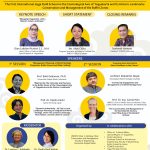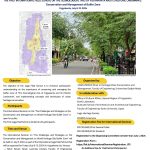Abstract
The sense of utilization and continuity of the historic urban landscape becomes more important than ever before. A city is not just about buildings and infrastructure, but it is also a place to live consisting of various social and cultural activities. A historic city is also not only a place of monuments and other tangible cultural heritage, but colored by living cultural heritage and somehow the new lifestyles created within heritage places as well. In many cases, an urban heritage is not just a place to be visited, but rather, a place to live and something to live with. Heritage, especially living heritage, can be anywhere, even side by side with contemporary architecture and new developments in the dynamic setting of space.
It is important to note the observation of Tung (2002) that “Cities cannot be sustained if they do not have a constituency to support the quality of life. The environment of the city is complex and dependent on many circumstances that are constantly changing and acting simultaneously. Ultimately, life in a city is too complicated to be objectively defined or engineered: it has to be experienced holistically”. This clearly defines that heritage is intrinsically part of the city environment, to which the conservation of the historic urban landscape should be holistically managed.
Urban heritage conservation is, therefore, not just about the past. It is also not only a preservation of a city’s historic fabric nor the beatification of a city center, but more about holistic approaches for natural, cultural, tangible and intangible heritage. Management of continuity, allowing for change is the central concept of conservation, a notion that differs from preservation. Consequently, this means that the changes which take place are not drastic in nature. The problem lies in how far these changes within the historic city can be called “natural”, and who are the actors that manage the continuity allowing this change?
Heritage conservation can be considered a cultural movement. The involvement of all stakeholders who are the actors in this movement, including the local communities and private sectors, are essential for resolving urban conservation issues, and strengthening the platform for the future development of historic cities. It is essential for citizens to be actively involved and participating, in order that our urban heritage can be well maintained and passed to future generations.
At the 29th General Conference of UNESCO, session in July 2005 (Durban, South Africa), the World Heritage Committee recommended “that the General Conference of UNESCO adopt a new Recommendation to complement and update the existing ones on the subject of conservation of historic urban landscapes, with special reference to the need to link contemporary architecture to the urban historic context” (Decision 29 COM 5D). Meanwhile, one of the recommendations stated in the Experts Meeting on ‘Managing Heritage Cities: the Role of Public-Private Partnerships’ co-organized by Asia Europe Foundation and Center for Heritage Conservation, Department of Architecture and Planning, Universitas Gadjah Mada, in Yogyakarta, Indonesia, July 2012, that Public-Private Partnerships (PPP) should focus on finding new functions for disused built heritage. PPPs have been recognized as a viable solution for sustaining the urban heritage as well as the heritage city as a whole.
The arrangement of mobilizing private sectors and engaging communities needs to be explored, implemented, and widely promoted in order to stimulate the utilization and continuity of urban heritage.
Author : Dr. Ir. Laretna T. Adishakti, M. Arch.
Mobilizing The Private Sectors and Engaging Communities For Urban Heritage



